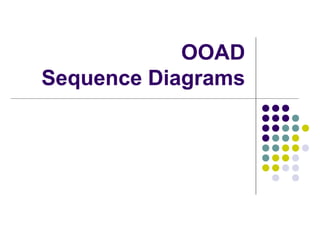
Ooad sequence diagram lecture
- 2. Interaction Diagrams Interaction diagrams describe exemplary how groups of objects collaborate in some behavior. An interaction diagram typically captures the behavior of a single use case. Interaction diagrams do not capture the complete behavior, only typical scenarios.
- 3. Types of Interaction Diagrams There are two types of interaction diagrams: Sequence diagrams emphasize the order or concurrency of the interactions. Collaboration diagrams emphasize the interacting objects.
- 4. Role of Interaction Diagrams in UML
- 5. Interaction Diagrams and Use Cases Behavior of the “order” use case: A customer orders several products. The (sub-)orders (“order lines”) for each product are prepared separately. For each product check the stock. • If the product is in stock, remove requested amount from stock. • If the product stock falls below a predefined level, reorder it.
- 6. Object Object naming: myBirthdy syntax: [instanceName][:className] :Date Name classes consistently with your class diagram (same classes). Include instance names when objects are referred to in messages or when several objects of the same type exist in the diagram. The Life-Line represents the object’s life during the interaction
- 7. Messages An interaction between two objects is performed as a message sent from one object to another (simple operation call, Signaling, RPC) If object obj sends a message to another 1 object obj2 some link must exist between those two objects (dependency, same objects)
- 8. Messages (Cont.) A message is represented by an arrow between the life lines of two objects. Self calls are also allowed The time required by the receiver object to process the message is denoted by an activation-box. A message is labeled at minimum with the message name. Arguments and control information (conditions, iteration) may be included.
- 9. Return Values Optionally indicated using a dashed arrow with a label indicating the return value. Don’t model a return value when it is obvious what is being returned, e.g. getTotal() Model a return value only when you need to refer to it elsewhere, e.g. as a parameter passed in another message. Prefer modeling return values as part of a method invocation, e.g. ok = isValid()
- 10. Synchronous Messages Nestedflow of control, typically implemented as an operation call. The routine that handles the message is completed before the caller resumes execution. :A :B doYouUnderstand() return Caller yes (optional) Blocked
- 11. Object Creation An object may create another object via a <<create>> message. Preferred :A :B :A <<create>> <<create>> :B Constructor
- 12. Object Destruction An object may destroy another object via a <<destroy>> message. An object may destroy itself. Avoid modeling object destruction unless memory management is critical. :A :B <<destroy>>
- 17. Why not just code it? Sequence diagrams can be somewhat close to the code level. So why not just code up that algorithm rather than drawing it as a sequence diagram? a good sequence diagram is still a bit above the level of the real code (not EVERY line of code is drawn on diagram) sequence diagrams are language-agnostic (can be implemented in many different languages non-coders can do sequence diagrams easier to do sequence diagrams as a team can see many objects/classes at a time on same page (visual bandwidth) 17
- 18. Lifetime of objects creation: arrow with 'new' written above it notice that an object created after the start of the scenario appears lower than the others deletion: an X at bottom of object's lifeline Java doesn't explicitly delete objects; they fall out of scope and are garbage-collected 18
- 19. Indicating selection and loops frame: box around part of a sequence diagram to indicate selection or loop if -> (opt) [condition] if/else -> (alt) [condition], separated by horiz. dashed line loop -> (loop) [condition or opt [balance 0] items to loop over] [balance 100.00] <> alt < [balance 100 ] >= .00 loop [balance 0] < 19
- 20. Concurrent Processes and Activations
- 21. Concurrency in Sequence Diagrams (1)
- 22. Concurrency in Sequence Diagrams (2)
- 23. Concurrency in Sequence Diagrams (3)
- 24. A Successful Bank Transaction Reference: Object-Oriented Analysis and Design J.W. Schmidt, F. Matthes, TU Hamburg-Harburg
- 25. A Failing Bank Transaction Reference: Object-Oriented Analysis and Design J.W. Schmidt, F. Matthes, TU Hamburg-Harburg
- 26. Sequence diag. from use case 26
